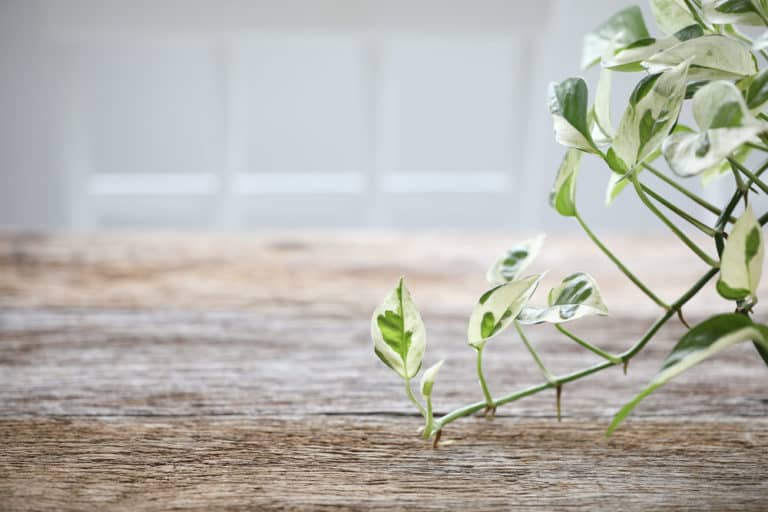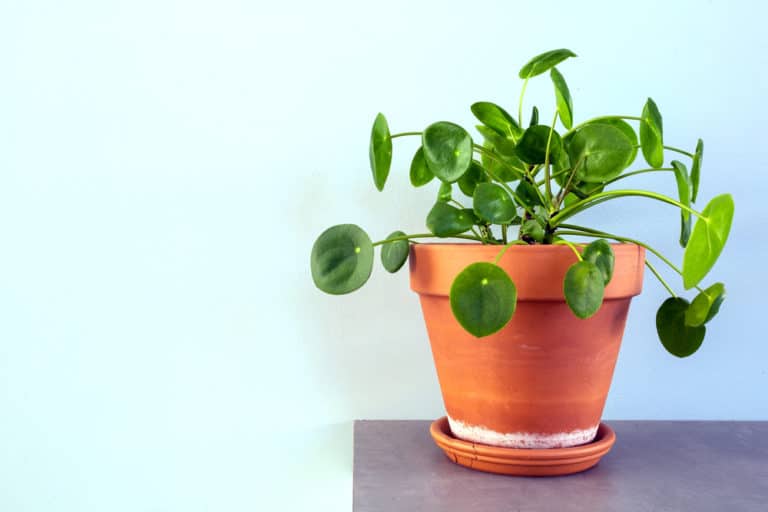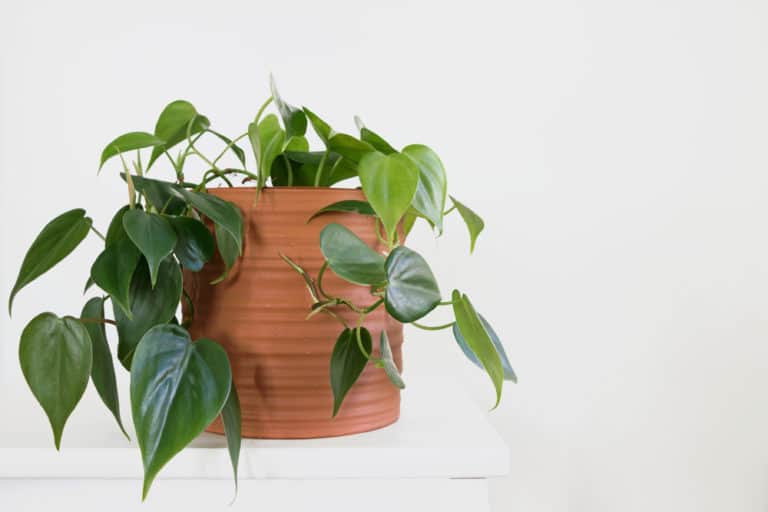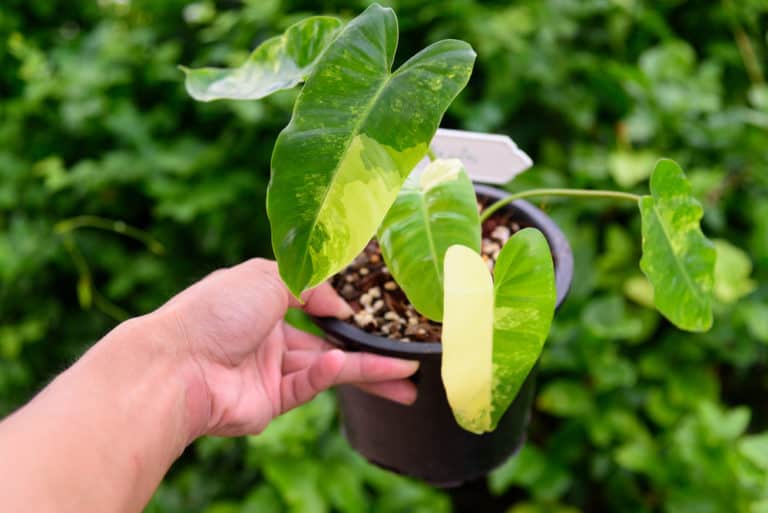Goeppertia Roseopicta ‘Rose-Painted Calathea’ Care (2024)
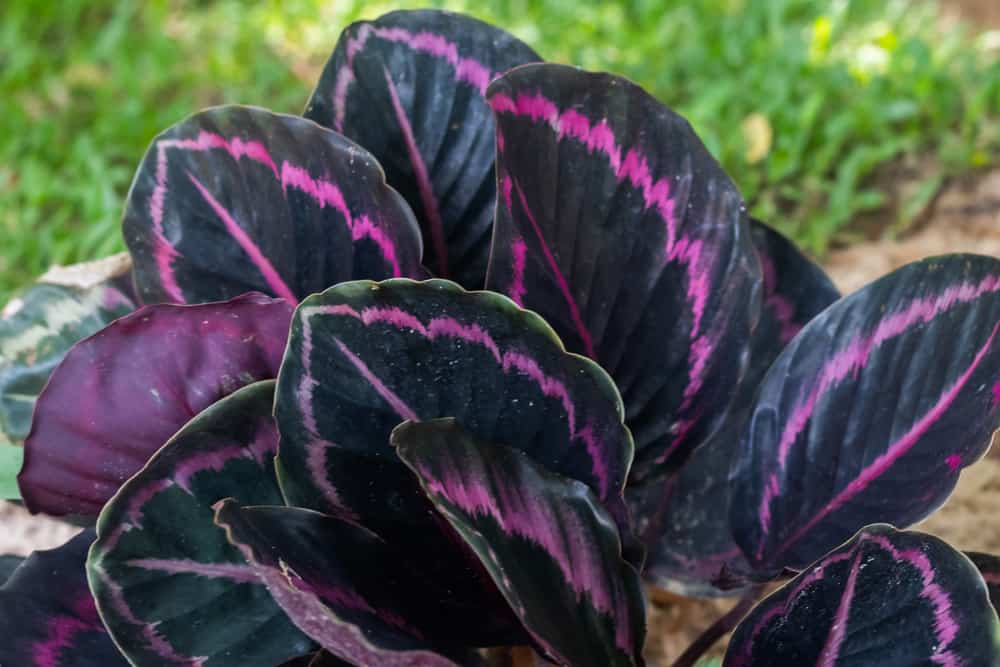
The rose-painted calathea is a stunning, small tropical beauty.
While it has recently been reclassified as Goeppertia roseopicta, it is still usually referred to as Calathea roseopicta.
It’s a little more challenging to grow than many houseplants, but for an experienced gardener, it’s a wonderful addition to your indoor garden.
| Scientific Name | Goeppertia roseopicta |
| Common Name | Rose-Painted Calathea |
| Light | Bright indirect sunlight |
| Watering | Water if the top half inch of soil is dry |
| Temperature | 64 to 85ºF (18 to 29ºC) |
| Hardiness Zone | 11 to 12 |
| Humidity | 60% |
| Soil Type | Rich, quick-draining, loamy |
| Soil pH | 6.5 (mildly acidic) |
| Fertilizing | A balanced feed once a month in spring and summer |
| Repotting | Every 2 years |
| Pruning | As needed to remove dead leaves |
| Propagation | Division |
| Toxicity | Not toxic to humans and pets |
| Mature Size | 20 inches as a houseplant |
| Bloom Time | Summer |
What’s Unique About Calathea Roseopicta?
The Calathea roseopicta plant is an evergreen perennial native to the tropical rainforests of northern Brazil, Colombia, Ecuador, and Peru, where it grows on the forest floor.
Calathea roseopicta plants were first discovered in the 1860’s. They soon became a desirable houseplant because of their stunning foliage in brilliant shades of green, cream, pink and purple.
While growing Calathea roseopicta can be overwhelming for a beginner, anyone with experience should be able to help this tropical plant thrive.
Roseopicta is particularly interesting as its leaves change their position throughout the day, unfolding in the morning and folding up as night falls.
Calathea Roseopicta Care
The Calathea rosy plant originates in the dense, humid rainforests of the headwaters of the Amazon.
Your Calathea roseopicta plant care needs to reflect those origins if you want it to thrive in your home.
Good rose-painted calathea care is all about keeping it well-watered in a warm, humid environment with bright but indirect light.
Light
In the rainforests of the Amazon, rose calathea grows far below the dense tree canopy, which protects it from the direct rays of the equatorial sun.
In your home, Calathea roseopicta light requirements are for bright but indirect light, or between 10,000 and 20,000 lux.
You will best be able to meet those rose-painted calathea light needs by setting it right in a north or east-facing window.
However, if all you have is a south or west exposure, be sure to set your rosy calathea in a location where it will not be in the full sun, which will damage the delicate leaves.
Watering
In the tropical rainforests of South America, Calathea roseopicta is used to rain falling several times a week, even during its “dry” season in winter.
It’s used to consistently moist conditions, but because they grow in spongy soil that drains well, they also will not tolerate sopping wet soil.
You need to water rose-painted calathea whenever the top half inch of the soil dries out during its growing season in spring and summer.
In winter you should cut back your Calathea roseopicta watering to when the top half of the soil has dried out.
In case you don’t meet its watering needs, Calathea roseopicta will let you know when its leaves start to curl inward.
Temperature
In the Amazonian rainforests, the average daily high never falls below 90ºF (32ºC), with average nighttime lows of 75ºF (24ºC).
You don’t need to keep it that hot in your home, however; the acceptable Calathea roseopicta temperature range is 64 to 85ºF (18 to 29ºC).
Basically, any temperature that is comfortable for you will be a good temperature for rose-painted calathea.
However, if you want to give your Calathea roseopicta a boost, you can take it outside for the summer to give it extra heat.
Be careful to bring it back in when temperatures start to drop, as it has little temperature tolerance below 60ºF (15ºC), and no frost hardiness at all.
Humidity
It’s just plain humid in the rainforests where Calathea roseopicta grows naturally. In fact, it’s hardly ever below 80%.
As a houseplant, the ideal humidity for rose-painted calathea is 60% or higher.
You may be able to get away with a humidity level of 40%, but if you start to see brown tips or margins on the gorgeous leaves, you need to do something.
The most labor-intensive way to satisfy Calathea roseopicta humidity requirements is by misting its leaves every day, but that is also the least effective.
You can set its pot on a pebble tray filled with water, or group all your plants together to create a moister microclimate.
However, the best solution is to buy a small humidifier that will target your plants without turning your whole house into a sauna.
Soil
Calathea roseopicta soil needs to be spongy and well-draining, with plenty of organic matter.
While Calathea roseopicta will not tolerate wet soil, it demands consistent moisture.
The best pH level for rose-painted calathea is 6.5, or mildly acidic.
A good commercial soil for rose-painted calathea is an African Violet soil mix, as the two plants have very similar requirements. An orchid potting soil would also work well.
You can also use a simple mix of two-thirds peat moss and one-third perlite for your Calathea roseopicta. Throw in a handful of well-rotted compost or worm castings to add some nutrients.
Fertilizer
The easiest Calathea roseopicta fertilizer is to simply add some nutrient-rich compost to the soil when you repot it. That should keep it going through one growing season.
However, if you have not done that, the best fertilizer for rose-painted calathea is a liquid indoor plant food with a fertilizer ratio of 10-10-10.
Dilute it to half the recommended strength and apply evenly across the soil surface shortly after you’ve watered.
If you start to notice brown tips on the leaves, you may have a build-up of fertilizer salts in the soil. You can remedy that by flushing the soil with a steady stream of water for about 10 minutes.
Potting & Repotting
Calathea roseopicta repotting should be done every 2 years.
Repotting rose-painted calathea is an opportunity to refresh the potting soil, which will give it a boost of fresh nutrients and avoid a build-up of pathogens.
You only need to increase the pot size if your Calathea roseopicta has become rootbound, which will be obvious.
A rootbound plant has roots growing out of the bottom drainage holes, or filling the entire pot.
Only go up 1 pot size, and make sure your new pot has good drainage holes.
Use a plastic or glazed clay pot to help the soil retain moisture.
Pruning
You won’t need to do much Calathea roseopicta pruning at all.
It naturally grows into a graceful form, and the leaves are so beautiful that you won’t want to sacrifice any unnecessarily.
However, you should always be prepared to cut out any dying leaves, as they will mar the appearance and can attract pests and disease. Cut them back to the soil level.
Sometimes a leaf will have minor imperfections like a brown margin or tip, and you don’t need to lose a whole leaf because of that.
Simply use sharp scissors to carefully trim off the unsightly bits and the rest of the leaf will be just fine.
When cutting rose-painted calathea, use sterilized scissors.
Propagation
Calathea roseopicta propagation is easily done when you are repotting your plant.
Calatheas grow from tubers, which naturally multiply and can start to crowd the pot.
To propagate rose-painted calathea, you start by pulling the root ball out of its pot, and cleaning off as much of the soil as possible.
Some of the plantlets forming around the edges of the mother plant may easily detach with just some gentle tugging.
However, don’t be afraid to use a sharp knife to cut them apart if necessary.
Make sure each tuber has roots and at least one good leaf.
Plant each new plantlet out in its own pot.
Also, make sure to check out our in-depth Calathea white fusion plant care guide.
Common Problems of Calathea Roseopicta
You should not encounter many Calathea roseopicta problems if you have started out by giving this plant the growing conditions it requires.
However, if you do have any problems with rose-painted calathea, it’s best to deal with them early before they threaten the health of your plant.
Regular inspections of the leaves should help you catch any issues before they develop too far.
Pests
The easiest way to deal with Calathea roseopicta pests is by never letting them get established.
You should wipe down the leaves of your rose-painted calathea once a month with a damp cloth, to keep them clean. Just add some insecticidal soap or neem oil and you should deter bugs from turning up in the first place.
Mealybugs form small fuzzy white clumps on the underside of leaves. Wipe them off with rubbing alcohol.
Scale insects attach themselves to stems and leaves and look like bumps. Scrape them off.
Aphids are small green insects on the stems and under the leaves.
Spider mites leave small yellow spots and spin sticky webs.
Both aphids and spider mites can be rinsed off in the shower or sink.
Diseases
Most Calathea roseopicta diseases result from poor watering practices, whether it’s keeping the soil too wet or getting water on the leaves. Both of these practices can foster fungal and bacterial diseases.
The most likely disease to affect rose-painted calathea is root rot, which is caused by soil that is so wet that the roots can’t breathe.
If your Calathea roseopicta has drooping, yellow leaves and mushy stems, and the roots are turning black, you need to trim off all infected parts.
Then, replant it in fresh soil in a clean pot.
Leaf spot can be a fungal or bacterial disease. When you start to see yellow, black or brown spots on leaves, cut out all affected leaves and improve air circulation around your Calathea roseopicta.
Growing Problems
Other growing problems aren’t caused by insects or disease, but by poor growing conditions. Improve those and your sick plant should recover.
Brown edges may mean that you’re using tap water that contains chemicals that are damaging your Calathea roseopicta. Use rainwater or distilled water.
Leafs curling inward are a clear indication that you’re underwatering your Calathea roseopicta.
Brown leaf tips or dropping leaves are a sign of low humidity.
Limp stems usually indicate that your Calathea roseopicta is too cold or overwatered, which can happen in winter if you’re not careful.
Faded leaves have been bleached by too much sun.
Toxicity of Calathea Roseopicta
The rose-painted calathea is not toxic to humans or animals.
Because of its lack of toxicity, you can use it in a home with pets or small children without worrying about taking them in for emergency medical care.
However, it’s a wise policy to keep them away from all your houseplants.
For Humans
Even though Calathea roseopicta is not toxic to humans, you should still take precautions when growing these plants in a home with children.
While there are no toxins that can trigger life-threatening reactions in a Calathea roseopicta plant, you still may be using pesticides or fertilizers on it.
As well, a small child may inflict damage on your houseplant by knocking it over or tearing at the foliage.
Finally, while Calathea roseopicta is safe, many other plants are not, and a small child will not be able to tell the difference.
It’s simply better to have a hands-off policy for all your houseplants.
For Pets
Your pets are not in danger of being poisoned by your Calathea roseopicta, but that does mean that they can’t have issues if they eat the foliage.
Cats and dogs are carnivores, and their digestive systems have evolved to process meat, not vegetables.
If your cat or dog eats too much of the leaves, they can end up in extreme gastrointestinal distress, leading to vomiting and diarrhea.
While you won’t have to rush them to the veterinarian, you may have to spend a few hours cleaning up after them.
You also won’t want your beautiful plant damaged by a bored pet.
Find a spot where your Calathea roseopicta will be safe from them, and vice-versa.
Calathea Roseopicta Appearance
While the common Calathea roseopicta appearance is that of large leaves brushed with vibrant color, there are many different varieties now available.
Dottie is an extremely popular variety, featuring dark green leaves with a roughly drawn pink oval pattern.
Corona has silvery green leaves with a broad border of deep green.
Foliage
The foliage of Calathea roseopicta is absolutely beautiful.
Each leaf has a glossy finish, with a bold pattern of feathery pink and red stripes on dark green leaves. As the leaves mature the stripes morph to creamy white.
The underside of the leaves is a deep reddish purple, which can be clearly seen at night when the leaves fold themselves up in response to low light levels.
Leaves first emerge rolled up tightly like a long purple tube, and then unfurl on their thick, reddish stems.
They grow to a length of 6 to 10 inches with a broad oval shape.
Flowering
It’s pretty rare to see a rose-painted calathea flower on a potted plant indoors.
Calathea roseopicta flowering is much more likely to occur when it’s grown outdoors year-round in a tropical climate.
If you do see your Calathea roseopicta blooming, you will just find insignificant white and purple flowers with a mild citrusy scent.
They certainly aren’t anywhere near as impressive as the evergreen leaves splashed with colorful patterns.
In fact, those flowers will sap energy that would otherwise go into producing more of those beautiful Calathea roseopicta leaves.
Many growers simply snip off the flower spikes before they bloom.
Size and Growth
The mature size of Calathea roseopicta grown indoors is about 20 to 30 inches, while an outdoor plant in a tropical zone may get to about 40 inches. They have a spread of about 20 inches.
They have a fast growth rate and will reach their full size within a single growing season.
Calathea roseopicta plants have multiple red stems, each one growing directly out of the rhizomes below the soil surface. Each stem has one leaf growing at its end.
Because it grows quickly, it’s a good idea to rotate the pot a quarter turn once a week to make sure the stems do not start leaning towards the brightest light.
Calathea Roseopicta Fragrance
While the rare flowers do have a light citrus scent, there is otherwise no Calathea roseopicta fragrance.
The evergreen leaves have no smell, good or bad, so it’s a good choice for a small space where a strong fragrance could be overwhelming.
Many public settings also don’t want to use heavily scented plants, out of consideration for people with sensitivities or allergies to fragrances.
Calathea roseopicta is perfect for those locations, especially because it has non-toxic leaves, making it perfectly safe for everyone.
As well, Calathea roseopicta is known to be an effective air purifier, removing contaminants from your indoor environment.
Suggested Uses for Calathea Roseopicta
With its splashy good looks and evergreen foliage, Calathea roseopicta is an excellent choice as an indoors houseplant.
It’s a perfect specimen plant against a white background in a contemporary space.
If you’ve got the room for it, a bathroom will give your rainforest native all the humidity it craves, while adding a tropical vibe.
Tucking a Calathea roseopicta in a corner in your bedroom will give you clean air as you sleep.
A row of potted Calathea roseopicta plants on your balcony or patio will create a vibrant living screen in summer in temperate zones, or year-round in tropical climates.
They also make excellent mass plantings in zones 11 to 12.
FAQ
What is Calathea roseopicta?
Calathea roseopicta, also known as Goeppertia roseopicta, is an evergreen perennial plant native to the tropical rainforests of Brazil, Colombia, and Ecuador. It is noted for its colorful foliage.
How to identify Calathea roseopicta?
Calathea roseopicta has large, ovate leaves with pink, red, or cream markings against a green background, and are purple on the undersides, with red stems.
How to care for Calathea roseopicta?
Calathea roseopicta should be grown in bright, indirect light in well-draining but rich soil that is kept consistently moist, in a warm and humid environment.
How to grow Calathea roseopicta indoors?
Calathea roseopicta is easily grown as an indoor potted plant, as long as it is kept in a bright spot out of the direct sun, and watered regularly.
How to grow Calathea roseopicta outdoors?
Calathea roseopicta can be grown outdoors year-round in zones 11 and 12, either as a container or bedding plant. In temperate zones it can be brought out in summer.
How fast does Calathea roseopicta grow?
Calathea roseopicta has a fast growth rate, and will reach its full size within one growing season. The evergreen leaves will remain through the dormant period in winter.
How tall does Calathea roseopicta grow?
Calathea roseopicta plants will reach a full height of 20 to 30 inches when grown indoors as a potted plant, while plants grown outdoors in the tropics may reach 40 inches.
How to make Calathea roseopicta grow faster?
Calathea roseopicta will grow faster when it is kept in the brightest possible spot short of full sun, with high heat and humidity, regular watering, and light fertilization.
How to stake Calathea roseopicta?
Calathea roseopicta does not need to be staked to maintain an upright growth habit, but rotate the pot a quarter turn once a week to prevent leaning.
How to pot Calathea roseopicta?
Calathea roseopicta should be planted in rich, peaty soil that drains well but will retain some moisture consistently, in a glazed or plastic pot with good drainage holes.
How to revive Calathea roseopicta?
If your Calathea roseopicta’s soil has dried out, give the pot a good soak in a pail of tepid water, and then keep it in a warm and humid location.
Why is my Calathea roseopicta dying?
Your Calathea roseopicta may have developed a bacterial or fungal disease from keeping its soil or leaves too wet. Cut off affected parts and replant it in fresh soil.
Why is my Calathea roseopicta drooping?
Your Calathea roseopicta stems may be drooping because they have been exposed to too cold a temperature or have been overwatered. Keep them out of drafts and cut back on watering.
How cold can Calathea roseopicta tolerate?
Calathea roseopicta will thrive in normal room temperatures and even hotter conditions outside. However, they will start to suffer below 60ºF (15ºC), and frost will kill them.
How to get rid of pests on Calathea roseopicta?
Calathea roseopicta pests can be controlled by wiping down the leaves monthly with a damp cloth wrung out in a neem oil or insecticidal soap solution.
Is Calathea roseopicta toxic to cats?
No, Calathea roseopicta is not toxic to cats. However, because cats are carnivores their digestive systems cannot handle much plant matter, so they might have vomiting and diarrhea.
Is Calathea roseopicta toxic to dogs?
No, Calathea roseopicta is not toxic to dogs. However, they still may end up with vomiting and diarrhea after eating the foliage, as they are naturally carnivores.
Is Calathea roseopicta toxic to children?
No, Calathea roseopicta is not toxic to children. However, they should be discouraged from handling any houseplants as many are dangerous and they will have difficulty distinguishing between them.
Is Calathea roseopicta toxic to humans?
No, Calathea roseopicta is not toxic to humans. You will not need to take any precautions such as wearing gloves when handling the plants, including pruning and potting.
Does Calathea roseopicta have a scent?
The infrequent Calathea roseopicta flowers do have a light citrus scent, but the potted plants rarely bloom indoors. The foliage has no scent at all.

